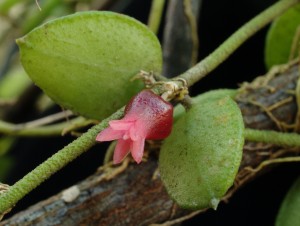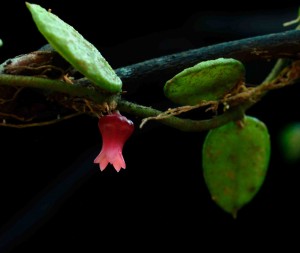Rewriting the Record Books
For over 100 years, the records in the Herbarium of the Singapore Botanic Gardens have listed Dischidia hirsuta as presumed extinct.
But last year, a team of researchers documenting Singapore's wild ginger population stumbled across it in a forest, thus rewriting the record books and bringing good news to conservationists in the country.
Searching for rare ginger, but finding something completely different
The team had been looking for rare Singapore ginger species in the forested areas of Upper Seletar Reservoir in May 2011, when we noticed a small inconspicuous plant growing on a fallen branch on the forest floor.
From a distance, it looked like a common epiphytic fern. Upon closer examination, we realised it had opposite fleshy leaves and milky sap. Despite it not being in bloom, it was identified as a species of Dischidia.
Initially, we paid little attention to our find. We brought a few cuttings with flower buds back to the Herbarium, so that we could confirm its identity after the flowers open.

The plant has fleshy leaves growing opposite along the stem and relatively large red blooms that turn pink at the tips. The stem and leaves exude a white milky sap when cut.
A lucky rediscovery
In the wild, these plants usually grow in the forest canopy. The plant found had probably fallen with the branch it grew on, or we would otherwise not have noticed it. Most of our attention was on searching the ground for traces of old ginger inflorescences that may contain ripe fruits and viable seeds for propagation.
Dischidia hirsuta, like most of Dischidia, are found growing on trees, often entwining them.
The plant flowered two weeks later. It was identified as Dischidia hirsuta, a plant with a rather wide distribution range that can be found in lowland forests from Myanmar to New Guinea.
However, when checked, the Herbarium records of D. hirsuta in Singapore showed it was last collected in Woodlands back in 1903 and since presumed extinct!
An important find for Singapore's biodiversity
Propagation by cuttings of the plant has begun, and we hope to reintroduce it to its natural habitat soon.
By Dr Michele Rodda
|
Re-introducing Dischidia hirsuta into Singapore Dischidia belongs to the same subfamily as the genus Hoya. Most of its species have a symbiotic relationship with ants and have milky sap. Hence they are sometimes known as ant plants or milkweed. Some of these plants can be found growing on roadside trees in Singapore. D. hirsuta can easily be sourced from neighbouring countries. But it is a morphologically very variable species, so propagation from native Singapore material is important to avoid the risk of introducing a non-native species. If you wish to learn more about the different varieties of Dischidia and Hoya plants found in Singapore, do visit the Flora and Fauna Web. |






Have views or comments on this article? Let us know via this form. If you would like to give us feedback on any other areas relating to our parks and gardens, please submit via https://www.nparks.gov.sg/feedback